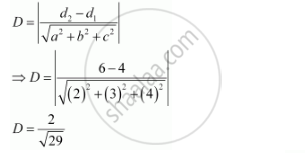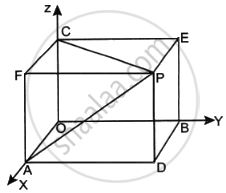Advertisements
Advertisements
Question
Distance between the two planes: 2x + 3y + 4z = 4 and 4x + 6y + 8z = 12 is
(A) 2 units
(B) 4 units
(C) 8 units
(D)`2/sqrt29 "units"`
Solution
The equations of the planes are
2x + 3y + 4z = 4 ....(1)
4x + 6y + 8z = 12
`=> 2x + 3y + 4z = 6 ...(2)`
It can be seen that the given planes are parallel.
It is known that the distance between two parallel planes, ax + by + cz = d1 and ax + by+ cz = d2, is given by,

Thus, the distance between the lines `2/sqrt29` units.
Hence, the correct answer is D.
APPEARS IN
RELATED QUESTIONS
Show that the points (1, 1, 1) and (-3, 0, 1) are equidistant from the plane `bar r (3bari+4barj-12bark)+13=0`
Find the distance between the point (7, 2, 4) and the plane determined by the points A(2, 5, −3), B(−2, −3, 5) and C(5, 3, −3).
Find the distance of a point (2, 5, −3) from the plane `vec r.(6hati-3hatj+2 hatk)=4`
Find the equation of the plane through the line of intersection of the planes x + y + z = 1 and 2x + 3y + 4z = 5 which is perpendicular to the plane x − y + z = 0. Also find the distance of the plane, obtained above, from the origin.
In the given cases, find the distance of each of the given points from the corresponding given plane.
Point Plane
(2, 3, – 5) x + 2y – 2z = 9
In the given cases, find the distance of each of the given points from the corresponding given plane.
Point Plane
(– 6, 0, 0) 2x – 3y + 6z – 2 = 0
Find the distance of the point (−1, −5, −10) from the point of intersection of the line `vecr = 2hati -hatj + 2hatk + lambda(3hati + 4hatj + 2hatk)` and the plane `vecr.(hati -hatj + hatk) = 5`.
Show that the points (1, –1, 3) and (3, 4, 3) are equidistant from the plane 5x + 2y – 7z + 8 = 0
Find the distance of the point (1, 2, –1) from the plane x - 2y + 4z - 10 = 0 .
Write the equation of a plane which is at a distance of \[5\sqrt{3}\] units from origin and the normal to which is equally inclined to coordinate axes.
Show that the points \[\hat{i} - \hat{j} + 3 \hat{k} \text{ and } 3 \hat{i} + 3 \hat{j} + 3 \hat{k} \] are equidistant from the plane \[\vec{r} \cdot \left( 5 \hat{i} + 2 \hat{j} - 7 \hat{k} \right) + 9 = 0 .\]
Find the distance of the point (2, 3, −5) from the plane x + 2y − 2z − 9 = 0.
Find the equations of the planes parallel to the plane x + 2y − 2z + 8 = 0 that are at a distance of 2 units from the point (2, 1, 1).
Show that the points (1, 1, 1) and (−3, 0, 1) are equidistant from the plane 3x + 4y − 12z + 13 = 0.
Find the equations of the planes parallel to the plane x − 2y + 2z − 3 = 0 and which are at a unit distance from the point (1, 1, 1).
If the product of the distances of the point (1, 1, 1) from the origin and the plane x − y + z+ λ = 0 be 5, find the value of λ.
Find the distance between the point (7, 2, 4) and the plane determined by the points A(2, 5, −3), B(−2, −3, 5) and C (5, 3, −3).
Find the distance of the point (1, -2, 4) from plane passing throuhg the point (1, 2, 2) and perpendicular of the planes x - y + 2z = 3 and 2x - 2y + z + 12 = 0
Find the distance between the parallel planes 2x − y + 3z − 4 = 0 and 6x − 3y + 9z + 13 = 0.
Find the equation of the plane which passes through the point (3, 4, −1) and is parallel to the plane 2x − 3y + 5z + 7 = 0. Also, find the distance between the two planes.
Find the equation of the plane mid-parallel to the planes 2x − 2y + z + 3 = 0 and 2x − 2y + z + 9 = 0.
The distance between the planes 2x + 2y − z + 2 = 0 and 4x + 4y − 2z + 5 = 0 is
The image of the point (1, 3, 4) in the plane 2x − y + z + 3 = 0 is
The distance of the line \[\vec{r} = 2 \hat{i} - 2 \hat{j} + 3 \hat{k} + \lambda\left( \hat{i} - \hat{j}+ 4 \hat{k} \right)\] from the plane \[\vec{r} \cdot \left( \hat{i} + 5 \hat{j} + \hat{k} \right) = 5\] is
If a plane passes through the point (1, 1, 1) and is perpendicular to the line \[\frac{x - 1}{3} = \frac{y - 1}{0} = \frac{z - 1}{4}\] then its perpendicular distance from the origin is ______.
Write the coordinates of the point which is the reflection of the point (α, β, γ) in the XZ-plane.
Find the distance of the point `4hat"i" - 3hat"j" + hat"k"` from the plane `bar"r".(2hat"i" + 3hat"j" - 6hat"k")` = 21.
Find the distance of the point (1, 1 –1) from the plane 3x +4y – 12z + 20 = 0.
Solve the following:
Find the distance of the point `3hat"i" + 3hat"j" + hat"k"` from the plane `bar"r".(2hat"i" + 3hat"j" + 6hat"k")` = 21.
Solve the following :
Find the distance of the point (13, 13, – 13) from the plane 3x + 4y – 12z = 0.
The equation of the plane passing through (3, 1, 2) and making equal intercepts on the coordinate axes is _______.
The equations of planes parallel to the plane x + 2y + 2z + 8 = 0, which are at a distance of 2 units from the point (1, 1, 2) are ________.
If the foot of perpendicular drawn from the origin to the plane is (3, 2, 1), then the equation of plane is ____________.
Find the coordinates of the point where the line through (3, – 4, – 5) and (2, –3, 1) crosses the plane passing through three points (2, 2, 1), (3, 0, 1) and (4, –1, 0)
Distance of the point (α, β, γ) from y-axis is ____________.
The distance of the plane `vec"r" *(2/7hat"i" + 3/4hat"j" - 6/7hat"k")` = 1 from the origin is ______.
Find the equation of the plane passing through the point (1, 1, 1) and is perpendicular to the line `("x" - 1)/3 = ("y" - 2)/0 = ("z" - 3)/4`. Also, find the distance of this plane from the origin.
Find the foot of the perpendicular from the point (1, 2, 0) upon the plane x – 3y + 2z = 9. Hence, find the distance of the point (1, 2, 0) from the given plane.
S and S are the focii of the ellipse `x^2/a^2 + y^2/b^2 - 1` whose one of the ends of the minor axis is the point B If ∠SBS' = 90°, then the eccentricity of the ellipse is
A stone is dropped from the top of a cliff 40 m high and at the same instant another stone is shot vertically up from the foot of the cliff with a velocity 20 m per sec. Both stones meet each other after
A metro train starts from rest and in 5 s achieves 108 km/h. After that it moves with constant velocity and comes to rest after travelling 45 m with uniform retardation. If total distance travelled is 395 m, find total time of travelling.
`phi` is the angle of the incline when a block of mass m just starts slipping down. The distance covered by the block if thrown up the incline with an initial speed u0 is
The coordinates of the point on the parabola y2 = 8x which is at minimum distance from the circle x2 + (y + 6)2 = 1 are
The equations of motion of a rocket are:
x = 2t,y = –4t, z = 4t, where the time t is given in seconds, and the coordinates of a ‘moving point in km. What is the path of the rocket? At what distances will the rocket be from the starting point O(0, 0, 0) and from the following line in 10 seconds? `vecr = 20hati - 10hatj + 40hatk + μ(10hati - 20hatj + 10hatk)`
Find the distance of the point (2, 3, 4) measured along the line `(x - 4)/3 = (y + 5)/6 = (z + 1)/2` from the plane 3x + 2y + 2z + 5 = 0.
If the distance of the point (1, 1, 1) from the plane x – y + z + λ = 0 is `5/sqrt(3)`, find the value(s) of λ.
Find the distance of the point (1, –2, 0) from the point of the line `vecr = 4hati + 2hatj + 7hatk + λ(3hati + 4hatj + 2hatk)` and the point `vecr.(hati - hatj + hatk)` = 10.
The acute angle between the line `vecr = (hati + 2hatj + hatk) + λ(hati + hatj + hatk)` and the plane `vecr xx (2hati - hatj + hatk)` is ______.
Find the coordinates of points on line `x/1 = (y - 1)/2 = (z + 1)/2` which are at a distance of `sqrt(11)` units from origin.
If the points (1, 1, λ) and (–3, 0, 1) are equidistant from the plane `barr*(3hati + 4hatj - 12hatk) + 13` = 0, find the value of λ.
The distance of the point `2hati + hatj - hatk` from the plane `vecr.(hati - 2hatj + 4hatk)` = 9 will be ______.
Find the equations of the planes parallel to the plane x – 2y + 2z – 4 = 0 which is a unit distance from the point (1, 2, 3).
In the figure given below, if the coordinates of the point P are (a, b, c), then what are the perpendicular distances of P from XY, YZ and ZX planes respectively?

